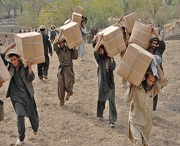
As international troops withdraw from Afghanistan, aid agencies will experience a titanic shift in their security infrastructure and be forced to reassess how they access those in need. Though the Taliban have a complex and predominantly hostile view of such agencies, those that wish to continue working in Afghanistan must learn to understand and negotiate with them. Yet, until now, little substantive research has been conducted on the Taliban to understand how to effectively engage with them.
Key Conclusions
- Based on nearly 40 interviews, researchers have found the Taliban political leadership has a clearly articulated policy on aid access, but there is a disconnect between the leadership and “field” Taliban.
- There is still a high degree of hostility among Taliban toward aid agencies, particularly when the latter are perceived as supporting the Afghan government and the international coalition.
- Military operations by the Afghan government or the coalition impact the level of dialogue with the Taliban, and thus humanitarian access.
- Although fraught with risks and challenges, aid agencies must pursue a more rigorous and systematic approach to engaging with Taliban at all levels.
Analysis
In 2012, the Overseas Development Institute (ODI) conducted nearly 40 interviews with the Taliban—from fighters to provincial commanders and Taliban leadership in Pakistan—to better understand their views of aid and aid agencies (the December 2012 ODI report on the topic can be found here).
The Taliban political leadership has a clearly articulated policy on aid access, which is a dramatic shift from years past when aid agencies were actively targeted. Aid agencies are expected to formally “register” with the Taliban, which requires them to meet several conditions, including neutrality, respect for “Afghan culture” and, in certain circumstances, payment of “tax.” Indeed, many aid agencies have secretly done so: the Taliban commissioner in charge of aid agencies provided a list of 26 registered organizations, including UN agencies, national and international NGOs, and human rights organizations.
While the Taliban’s political leadership is attempting to convey a strong and united movement and an open attitude towards aid actors, its ability to ensure that Taliban fighters follow “official policy” is, in reality, limited. Ground commanders interviewed in the two provinces studied (Kandahar in the south and Faryab in the north) were aware of the policy. But in practice, the rules are fluid and vary depending on who is in charge, and the degree to which they are implemented is influenced by military pressure, territorial control, and personal inclinations.
Regardless of the “rules,” there is a high degree of hostility towards aid actors. In interviews, members of the Taliban repeatedly levelled accusations that such actors are spying for foreign governments or at their service. Some more radical Taliban felt that cooperation with international military forces made aid agencies legitimate targets.
Counterinsurgency tactics have also influenced their perceptions. Many reported they were amenable to granting aid access, but changed their minds when they saw agencies increasingly working only in government-controlled areas and coming to former Taliban strongholds only after they had been “cleared” by international forces. Consequently, those agencies that were perceived as neutral and independent by the Taliban ultimately had greater access and security.
But these weren’t the only negative views of aid agencies. The Taliban, and indeed many ordinary Afghans, felt that aid was distributed in an imbalanced way and prioritized the powerful. There was also anger at ineffective aid projects and corruption, with one Taliban commander complaining that “huge amounts are spent in Kandahar but we have not seen any project during the last decade that has brought any positive change to our lives.” Poor-quality projects in turn reinforced suspicions that aid agencies had ulterior motives.
There are also tensions between the Taliban political leadership and its military commanders. While the Taliban’s political wing favors granting conditional humanitarian access, the military commanders unsurprisingly react to military attacks (such as night raids and airstrikes) by restricting it. Such concerns are clearly subordinate to military objectives.
Combined with general suspicion of aid agencies, there are often dangerous consequences. After international forces conducted raids and detained several key Taliban in Faryab, a Taliban commander attacked NGO staff whom he believed had tipped them off. What proof he had to substantiate this assertion was unclear.
In interviews, other sources of fragmentation within the Taliban emerged. The International Security Assistance Force’s kill/capture campaign targeting senior and mid-level commanders resulted in increased volatility of Taliban command. Heavy losses have led to an influx of young, more radical commanders. There are substantial differences in motivations and behavior between local Taliban, who have largely pragmatic reasons for being part of the insurgency, and Taliban from other parts of Afghanistan or from Pakistan and Uzbekistan, who are often younger and more likely to be ideologically motivated. Hardline jihadists were generally disruptive to aid access, in contrast to more moderate local Taliban, who were typically well connected with communities and more likely to listen to their appeals for aid and basic services.
Engaging with the Taliban on issues of aid access is fraught with challenges, and the withdrawal of international troops in 2014 will bring even greater uncertainty. Aid agencies clearly need to pursue a more rigorous and systematic approach with the Taliban, engaging at all levels. While it presents formidable risks and challenges, pursuing a structured, informed approach to dialogue is increasingly critical for agencies committed to continuing to work in Afghanistan.
Ashley Jackson is a Research Fellow with the Humanitarian Policy Group and co-author of the ODI report “Talking to the Other Side.”
Photo credit: United Nations Radio




